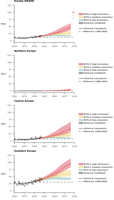
The hot days index represents the total number of days in a year registering maximum daily temperature above a fixed threshold. 30 °C is here considered as a suitable threshold at pan-European level, but higher thresholds can be considered depending on the regional climate conditions.

The cooling degree days index represents a proxy for the energy demand for cooling buildings. It is computed from the outdoor air temperature as cumulated daily deviation above a given base temperature threshold from April to September (see the ETC-CCA Technical Paper for details). The temperature threshold, period and formulation of this index can vary according to the local climate and applications. A base temperature of 22 °C is considered here as representative for assessing the energy demand at the pan-European scale and daily minimum, mean and maximum temperature values are used as input ECVs.

The heating degree days index represents a proxy for the use of energy required for heating buildings. It is computed from the outdoor air temperature as the cumulated daily deviation from a base temperature threshold from October to March (see the ETC-CCA Technical Paper for details). The temperature threshold, period and formulation can vary according to the local climate and applications. A base temperature of 15.5 °C is considered here as representative for the pan-European scale and daily minimum, mean and maximum temperature values are used as input variables.

The growing degree days index represents a measure of the accumulated heat available for vegetation growth. It is calculated as the accumulated sum over the year of the daily mean temperature exceedances of a base threshold (see the ETC-CCA Technical Paper for details). A base temperature of +5 °C is considered as representative for most European crops. Other definitions of the index are possible, including variations of the minimum temperature, the use of an upper temperature threshold, and restrictions to a given growing season.

Grid boxes outlined in solid black contain at least three stations and so are likely to be more representative of the grid box. Significant (at the 5 % level) long-term trend is shown by a black dot (In the map above, this is the case for all grid boxes). The map below shows average annual air temperatures over Iberian Peninsula and Scandinavia, respectively.
Document Actions
Share with others